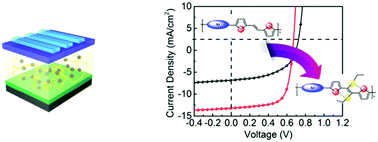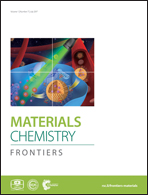Significantly improving the efficiency of polymer solar cells through incorporating noncovalent conformational locks†
Abstract
Noncovalent conformational locks have been widely employed to construct highly planar and rigid conjugated systems for organic electronics. In this paper, two conjugated polymers (PDTffBT–TVT and PDTffBT–TVTOEt) were synthesized through the Stille coupling of 4,7-di(thien-2-yl)-5,6-difluoro-2,1,3-benzothiadiazole (DTffBT) with (E)-2-(2-(thiophen-2-yl)vinyl)thiophene (TVT) and (E)-1,2-diethoxy-1,2-di(thiophen-2-yl)ethane (TVTOEt), respectively, to investigate the effect of incorporation of the S⋯O noncovalent conformational locks on the performance of the polymer based bulk heterojunction solar cells. The physicochemical properties and photovoltaic characteristics of the conjugated polymers were fully investigated with different characterization techniques, which demonstrated that incorporation of the noncovalent conformational locks improved the rigidity of the backbone, leading to enhanced charge transport mobilities, and thus higher Jsc and FF. As a result, the efficiencies of the solar cells were significantly improved from 2.59% (PDTffBT–TVT) to 6.16% (PDTffBT–TVTOEt).

- This article is part of the themed collection: Next-Generation Organic/Hybrid Photovoltaics

 Please wait while we load your content...
Please wait while we load your content...